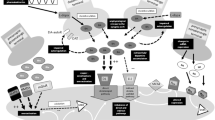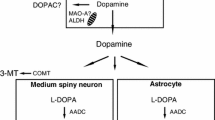Summary.
L-Dihydroxyphenylalanine (L-DOPA), the anti-parkinsonian drug affording the greatest symptomatic relief of parkinsonian symptoms, is still misunderstood in terms of its neurotoxic potential and the mechanism by which generated dopamine (DA) is able to exert an effect despite the absence of DA innervation of target sites in basal ganglia. This review summaries important aspects and new developments on these themes. On the basis of L-DOPA therapy in animal models of Parkinson’s disease, it appears that L-DOPA is actually neuroprotective, not neurotoxic, as indicated by L-DOPA’s reducing striatal tissue content of the reactive oxygen species, hydroxyl radical (HO•), and by leaving unaltered the extraneuronal in vivo microdialysate level of HO•. In addition, the potential beneficial anti-parkinsonian effect of L-DOPA is actually increased because of the fact that the basal ganglia are largely DA-denervated. That is, from in vivo microdialysis studies it can be clearly demonstrated that extraneuronal in vivo microdialysate DA levels are actually higher in the DA-denervated vs. the intact striatum of rats – owing to the absence of DA transporter (i.e., uptake sites) on the absent DA nerve terminal fibers in parkinsonian brain. In essence, there are fewer pumps removing DA from the extraneuronal pool. Finally, the undesired motor dyskinesias that commonly accompany long-term L-DOPA therapy, can be viewed as an outcome of L-DOPA’s sensitizing DA receptors (D1–D5), an effect easily replicated by repeated DA agonist treatments (especially agonist of the D2 class) in animals, even if the brain is not DA-denervated. The newest findings demonstrate that L-DOPA induces BDNF release from corticostriatal fibers, which in-turn enhances the expression of D3 receptors; and that this effect is associated with motor dyskinesias (and it is blocked by D3 antagonists). The recent evidence on mechanisms and effects of L-DOPA increases our understanding of this benefical anti-parkinsonian drug, and can lead to improvements in L-DOPA effects while providing avenues for reducing or eliminating L-DOPA’s deleterious effects.
Similar content being viewed by others
Author information
Authors and Affiliations
Rights and permissions
About this article
Cite this article
Kostrzewa, R., Nowak, P., Kostrzewa, J. et al. Peculiarities of L-DOPA treatment of Parkinson’s disease. Amino Acids 28, 157–164 (2005). https://doi.org/10.1007/s00726-005-0162-4
Received:
Accepted:
Published:
Issue Date:
DOI: https://doi.org/10.1007/s00726-005-0162-4




